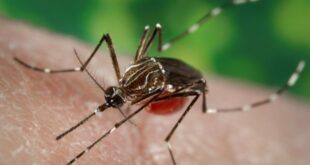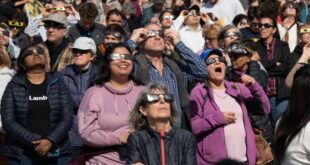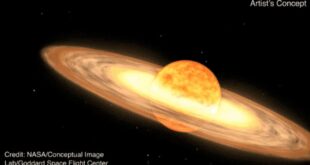‘We are part of nature, and what we do to nature we do to ourselves,’ says one naturalist.

With Canada coming out of its warmest winter on record, some may be enjoying the signs of spring that are showing up much earlier this year: plants beginning to pop up out of the ground, the earlier calls of robins or migrating birds or even just the warmer and sunnier days.
But this isn’t good news for the natural world.
Climate change is altering the way animals, insects and plants behave, and has cascading effects in delicately balanced ecosystems.
With longer springs, ticks are moving northward, bringing the chance of disease in animals and humans alike.
Likewise, mosquitoes — another disease carrier — are coming out earlier and are able to breed more often, thanks to warmer and sometimes wetter weather conditions. Already mosquito-borne diseases have increased by 10 per cent in Canada.
And while people may think of the iconic polar bear, floating on a lone floe in the Arctic with nowhere to go, as a symbol of the effects of climate change, there’s not a species of bear that isn’t affected.

Cherry blossoms bloom early in Washington, D.C.
The U.S. capital’s famous Yoshino cherry trees reached peak bloom just three days shy of the record set on March 15, 1990. Admirers descended on the National Mall and Tidal Basin park system to view the blossoms, which will last for a few days depending on the weather.
Take Genie, for example. The 13-year-old American black bear who lives at the Ecomuseum in Ste-Anne-de-Bellevue, Que., usually emerges from hibernation near the end of March. This year, she emerged on March 1. It’s only the second time she’s come out of hibernation that early. The first time? During the last El Niño winter, in 2016.
This was also an El Niño winter, and Ontario’s Ministry of Natural Resources has warned residents that bears are emerging earlier this year.
The weather experienced during El Niño, the cyclical warming of a particular area of the Pacific Ocean, could be a harbinger of things to come, says one naturalist.
They are “a window into what the future of climate change presents to us,” said William B. Karesh, executive vice president for health and policy at EcoHealth Alliance. “They’re test runs.”
El Niño asideoverall climate change is also changing the habits of some bears. Some American black bears not hibernating at all, due to both a warmer world and continuing food sources, mainly food provided unintentionally by humans.
Bears hibernate — or, more accurately enter torpor, a light, prolonged sleep — when weather gets colder and food sources diminish. But with a warmer climate, food sources may remain, and there is no need for them to sleep.
That means there may be a greater chance of them interacting with people in their search for food.

Threats to birds
One of the most pleasant things about spring is the arrival of birds, their song brightening up a warm day. But birds are under extreme threat due to climate change.
According to a 2019 study by the National Audubon Society, two-thirds of North American birds are at risk of extinction due to climate change.
Their migration times are shifting, meaning they may show up before — or even after — their food sources emerge, something called asynchrony. But that’s not the only climate-related threat.
“As as the climate warms, things like West Nile virus, malaria, avian influenza, these these diseases are are are spreading and moving, certainly in part because of of climate-related effects,” said Ted Cheskey, naturalist director at Nature Canada.
“Those things are having a big effect on some species populations. The greater sage grouse, this iconic chicken-like bird that lives in the Prairies. Habitat loss is one thing … and then West Nile comes along it’s kind of like a death blow.”
He thinks there are about 100 such birds left in Canada. “So yeah, it’s kind of depressing.”
There’s also concern over animals that are altitude dependent. As temperatures continue to rise on a mountain, for example, the animals may move to higher elevations to where the climate is more suited to them.
Other, smaller animals are also struggling to adapt.
“I’ve noticed in Connecticut, the spring peepers, the little frogs that come out, started a few weeks ago,” said Karesh. “It’s pretty early in the season when that’s happening now.”
Nathalie Jreidini, a biologist and educational director at Ecomuseum, says there have been similar reports in Ontario. But another problem, even though we are seeing warmer temperatures, is that we also still get cold spells. Which, of course, are especially dangerous to amphibians.
“If they’re not hidden away at the bottom of the water or under muddy areas, which is how they go into their torpor or their version of hibernation, then you will have a lot of death,” said Jreidini about the spring peepers.
“And that’s the main issue of the more vulnerable species versus you know, a larger mammal can still hide or still has enough fur to keep it warm.”
While some animals will adapt to climate change, others won’t, and it just isn’t clear at the moment how big the consequences will be.
Any threat to nature is a threat to humans, naturalists say, with more invasive species taking root, a threat to pollination of our crops, to more climate-related disasters like coastal erosion.
“This is where I would advocate for more of an Indigenous worldview. I think we need to think that we’re part of that web of life,” Cheskey said. “It’s not ‘us in nature.’ It’s ‘we are part of nature, and what we do to nature we do to ourselves.'”
ABOUT THE AUTHOR

Senior reporter, science
Based in Toronto, Nicole covers all things science for CBC News. As an amateur astronomer, Nicole can be found looking up at the night sky appreciating the marvels of our universe. She is the editor of the Journal of the Royal Astronomical Society of Canada and the author of several books. In 2021, she won the Kavli Science Journalism Award from the American Association for the Advancement of Science for a Quirks and Quarks audio special on the history and future of Black people in science. You can send her story ideas at Nicole.Mortillaro@cbc.ca.
*****
Credit belongs to : www.cbc.ca
 Atin Ito First Filipino Community Newspaper in Ontario
Atin Ito First Filipino Community Newspaper in Ontario






